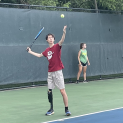Wearable Sensors for Fever Detection in Children with Cancer in Kenya: An Implementation Science Study

Over 90% of the children in the world diagnosed with cancer live in low-income countries (LMICs), and only 1/3 of them are cured. These increased deaths are partially attributed to infections as these children in LMICs are >20 times more likely to die from fevers, made worse with moderately (>3 hours) and severely (>24 hours) prolonged treatment delays. Prompt treatment improves fever outcomes, yet this is challenging in LMIC hospitals due to nurse shortages (1 nurse to 30 patients). Our study in Kenya found many deaths (6%) with antibiotics delayed from time of fever detection (9 hours) and with no fevers detected at night. Delays in fever detection from onset of fever event contribute to delay antibiotic administration, poor outcomes, and preventable deaths. Wearables in children are feasible, acceptable, accurate in vital sign monitoring (e.g., temperature, heart rate) as often as one per second, and can predict when an infection will worsen and detect fevers on average 5 hours earlier. We even published a study where a wearable detected fevers from bacterial blood infections 12 hours before a thermometer in children with cancer. Shifting the task of fever detection from nurses with high workloads to a temperature wearable is an innovative solution to prevent death from infections in children with cancer in LMICs. Yet, important knowledge gaps exist which prevent effective use of wearables in LMICs; no one has published studies of wearables in children with cancer in Africa.
Project Goal:
To keep a long-term mindset, we will use implementation science frameworks and techniques which provide a detailed blueprint to ensure we rigorously evaluate all the different aspects of using wearables in Kenya. The resources available LMICs are different than those in the US, so we will first interview healthcare workers and government agency leaders to ask them if wearables are appropriate here in Kenya, how well it will be adopted in the healthcare setting, and what price point is ideal. Currently, the children on our cancer ward never wear any sticker or medical sensor longer than a few minutes. Therefore, we’re going to talk with children, parents, and nurses to get their perspectives on them and what the attributes they desire and which to avoid. It’s important to understand these factors so we carefully select the temperature wearable sensor for the trial. For example, the trial will fail if children don’t like having a sticky patch on their forehead, or if it needs WIFI to upload data but the internet at the hospital is out all the time. We expect that after learning the challenges in the hospital, views of government agencies, and learn the desirable attributes of a wearable, we will not only be able to successfully conduct a trial to show the wearable can be used and is liked by children, but will also show how these can be used long-term to improve fever management in children with cancer and stop preventable deaths; no child with cancer should die from a fever.

